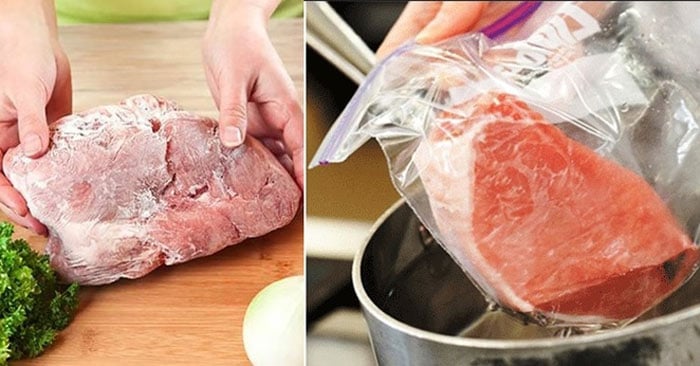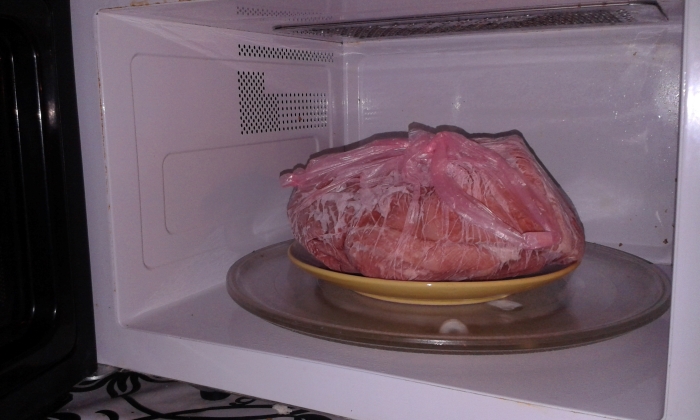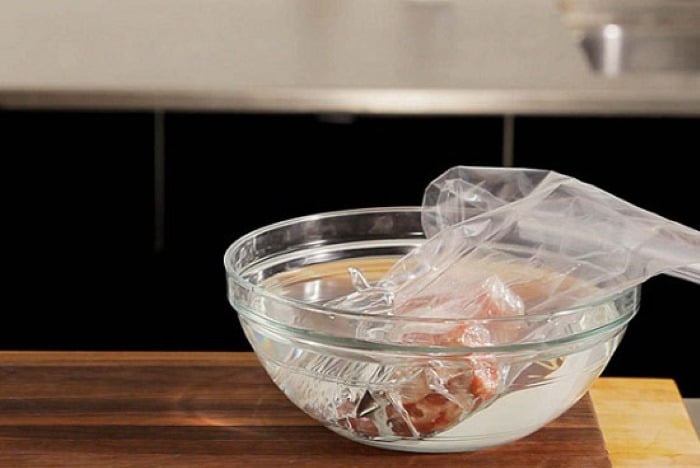2 Common Meat Defrosting Mistakes and 3 Scientific Ways to Do It Right
1. Defrosting at room temperature
Nutritionists advise against defrosting meat at room temperature for more than two hours. As the ice melts, the temperature of the meat increases, creating an opportunity for bacterial growth. Bacteria such as Staphylococcus, Salmonella, Campylobacter, E. coli, and others can thrive between 4-60 degrees Celsius.
Within this temperature range, the number of pathogens can double in as little as 20 minutes.

2. Defrosting meat with hot water
This method is unscientific as only the outer surface of the meat thaws while the inside remains frozen. This means that the outer layer can reach a “danger zone” temperature, fostering bacterial growth and toxin development even as the inside stays frozen.
3 Scientific Ways to Defrost Meat
1. Defrost in the refrigerator
The safest and most effective method is to transfer the frozen food from the freezer to the refrigerator and wait. However, this process can be time-consuming.
2. Defrost in the microwave
Defrosting meat in the microwave is quick and convenient, especially for smaller pieces of meat. However, it’s important to cook the meat immediately afterward. Refreezing thawed meat can lead to rapid bacterial growth and a loss of flavor.

Defrosting in the Microwave
3. Defrost by submerging in cold water

Defrosting by Submerging in Cold Water
This method involves placing the meat in a sealed bag and submerging it in a bowl of cold water, which is a safe and effective way to defrost.
defrosting-top-chefs-tips-for-perfectly-fresh-meat-in-just-5-minutes/’ title=’The Ultimate Guide to Quick Meat Defrosting: Top Chef’s Tips for Perfectly Fresh Meat in Just 5 Minutes!’>The Ultimate Guide to Quick Meat Defrosting: Top Chef’s Tips for Perfectly Fresh Meat in Just 5 Minutes!
The Ultimate Guide to Thawing Frozen Foods for Tet: Preserve Nutrients, Taste, and Quality
The great freezer conundrum: a challenge faced by many. Meat, fish, and shrimp are often stashed away in the icy depths of freezers, but the age-old question remains – how best to thaw? Forget the old wives’ tales of hot water, salty ice baths, or leaving food to defrost at room temperature. It’s time to embrace a new era of thawing wisdom and discover the optimal method that will revolutionize your culinary adventures.
The Ultimate Kitchen Hacks: Secrets to Becoming a Master Chef at Home
The kitchen is an integral part of every home, and for good reason. It’s a place where culinary magic happens and where hearts are often poured out. But, let’s face it, cooking can be a daunting task, and even the most seasoned home cooks can use a helping hand from time to time. That’s why we’ve put together a list of handy tips and tricks to help you conquer the kitchen like a pro and make your time there a little more enjoyable.






































